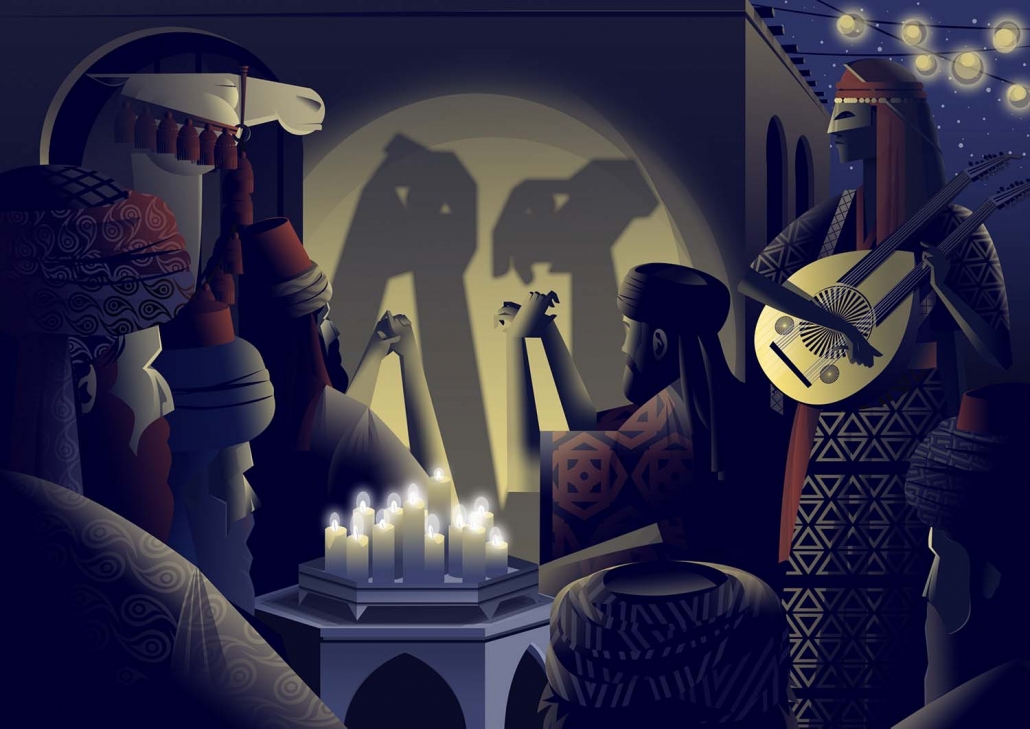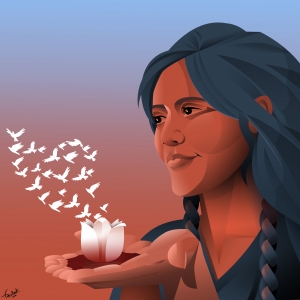Here is a review I wrote for University of the Arts Bremen (Hochschule für Künste Bremen) as an assignment. A review on group exhibition: “70-80” held from January 6th to 16th 2023, Tehran, Iran
This version here has been edited few times as i had more time for it of course.
It has been a while since art galleries and artists in Iran are on a general strike due to the recent anti-government protests begun in September 2022. There was almost no art exhibition and similar events for the past four months. In fact, considering the Covid-19 restrictions on public art events, only few of them have been held here in Iran since mid 2019.

However, there have been numerous group exhibitions by young artists most of which were held virtually via internet.
The “70-80” exhibition is one of those recently-held virtual art events presenting latest works of eight young Iranian artists under 30. As a matter of fact, the title “70-80” itself refers to the age of participants meaning those who were born in 1990s (Persian calendar’s 1370s) and 2000s (Persian calendar’s 1380s). Mohadese Taheri, Hoori Benam, Faeze Foadian, Arash Mozhdeganlou, Ghazaleh Khoshghadam, Pouyan Taherianfard, Farino Atlasi and Rojano Mohamadzade are the eight artists whose paintings are curated at Arthibition Gallery virtual walls*.
The gallery aside from the art and aesthetics, is personally interesting to me as an artist born in 1980s since it shows the huge gap between my generation and the selected artists’. The way those young artists born in the late 90’s see the world has totally altered from what previous generations and I used to see it. The gallery is particularly noteworthy to me as more than half of the artworks (17 out of 32) are portraits, self-portraits, and group portraits.
To many, portraits are magical mirrors; Mysterious portals leading to human’s soul and reflecting what subject of the portrait or the artists her/himself thinks, believes, and states. Therefore, I decided to write only a review on the portraits and the things they have in common which I find related to the artists’ age rather than the curator’s choice.
Pointing out the similarities – I believe- can give us a small vent to look through the new generation of Iranian artists. The portraits, at a general glance, are all gloomy images of women who are neither satisfied nor cheerful if not interpreted as sad or desperate. The cold color palette of most of portraits likewise gives us the same vibe and amplifies the blue atmosphere and dejected ambience of subjects trying to address the audience with hopeless gazes and icy scowls.

Mohadese Tahri’s Artworks in exhibition 70-80 (Down-left shows golden ratios in one of her artworks)
Starting with the self-portraits of 1997-born artist, Mohadese Taheri, she has painted herself in front of apocalyptic landscapes with no trace of humanity as if she is the only survivor of armageddon. Though she is not yet a well-recognized painter, I had seen some of her other works in different exhibitions before: all are oil self-portraits with the similar dark backgrounds whose subjects seem to suffer from a long chronical pain which has made her numb and despondent. This numbness is yelled out through her soft brush strokes and the artworks’ golden compositions dragging the audiences’ attention smoothly from the subject’s eyes deep into the mysterious world in the back.
Personally, I can relate her artworks’ atmosphere to the situation in which her generation -specially women- was raised and brought up: dark economic prospect, tightened cultural norms and imposed choices upon education, career, and living in general. This was the case for a few generations before too -including mine- but the difference is that the improvements of global communications in the 90s and 2000s has put them in an ever-present exposure with the other societies benefiting from all they are longing for. We -mostly generations born in 80s, 70, and 60s- were convinced to believe that we were the luckiest and happiest people in the world heading on our way to build a utopia over the ruins of a frustrating 8-year war (Iran-Iraq war 1980-1988). We had no idea how the rest of the world was doing in that dark communication era. We believed what we were told to believe via state TV or radio which was mostly hand selected realities and propaganda. Hence, we had less chances to see the truth and because of not being able to compare ourselves to our fellows overseas, we had less chances to feel disappointed. But to the generation born in the late 90s, our cultural and economic restrictions are a heavy load. Since early childhood, they were constantly reminded about the better situations they could live in. This could seriously trigger a dissatisfaction chain reaction making them see the world a different place with many out-of-the-way alternatives for living. Their art is different, and so is their lifestyle.

4 pieces of Hoori Benam’s artworks in exhibition 70-80
This dark perception also flows in the portraits made by another 1997-born artist, Hoori Benam. She also uses a cold palette in her paintings. Though her portraits lack apocalyptic landscapes -as Mohadese’s- and use more simple neutral backgrounds, we can trace those end-of-the-time scenery in one of her non-portrait paintings exhibited in the same gallery. One of her portraits is a young girl -maybe a child- with a pale face taking a colorless glance at the audience. The girl seems detached and frozen, finding everything pointless. Maybe the gesture is not an unusual face as many children may have the same face when embarrassed or annoyed but the pale color tone, the vagueness of the frame, and wet watercolor brush strokes imply that this is no ordinary situation and the subject is not an ordinary child. Maybe it would be an over-analyzed comment if we suppose the portrait is based on one of those old pale photos that many of us have in our albums. Assuming so, the artwork could be a self-portrait, a vague image of the artist’s lost -or at least passed- childhood. While seeing Hoori’s three portraits in the exhibition, which all reminded me of old photographs, I was thinking that thanks to handy-cams, abundance of photograph films and emergence of new digital cameras in 90s and 2000s, why should the childhood of a person from this generation be vague? I suppose that unlike my generation, they must have a record of every event of their life such as birthdays, first day of schools, proms, reunions, etc. I suspect that maybe this artist imagines her own world as a mentally vague place lacking a specific identity as an Iranian child. But lack of identity is a vast concept caused by myriads of socio-cultural factors we cannot trace back in a review. So, maybe it is enough to presume that in spite of many capturing technologies available in the late 90’s, people born back then can also perceive their past as a cold vague place missing clear memories just as reflected in Hoori’s portraits.

Faeze Foadian’s artworks in exhibition 70-80
Faeze Foadian, unlike the other artists mentioned above, used a warmer palette and her choice of charcoal and pastel lines makes her portraits seem more energetic and active, suggesting an inspiring anger and rage in addition to feeling fatigued, disappointed, and aimless. Faeze seems to have no social profile or web footprint -which is uncommon for a young artist of our time- so I have not been able to say how old she is and whether her portraits, which are all a same woman, are self-portraits or not. Using symbols, emphasizing on a short-haired -too short and untidy- female portrait can indicate some cultural contexts such as mourning, loneliness, lack of enthusiasm, combat, and even crime. Regarding the frown and decisive face gestures of all four paintings, the artist’s message could be interpreted as of Mohaddaseh’s and Houri’s: illustrating a toxic environment where hope is dead and the subject is succumbed. Warmer colors like red in some of her works also implies that Faeze’s portraits feel infuriated and are thinking of a courageous reaction or maybe taking a revenge. Though the flow of life is more tangible in Faeze’s portraits but they do not tell stories of a joyful moment or even a normal life. The audience can feel some levels of pressure, pain, and uncertainty in the subjects’ eyes.

Artwork by Arash Mojdeganlou in exhibition 70-80

2 pieces of Ghazaleh Khoshghadam’s artworks in exhibition 70-80
Putting all these portraits of three different and unrelated artists of the same age can ratify our assumptions of their generation’s fears, emotions, and hesitations. However, taking a glance at other participating artists portraits also gives us the same conclusion: No joy of life is found in the face of a drowning (or sleeping) girl of Arash Mozhdeganlou and hopeless faces are seen in portraits of Ghazaleh Khoshghadam. Similarly, their color tone is rather cold and even one of Ghazaleh’s portraits, with strange patterns on her dace and a green background make us think of a corpse decomposing of maybe a decaying hope or feeling.
To sum up, over generalizing a generation’s thoughts and feelings upon a dozen of portraits may seem unreliable. On the other hand, though, it is no accident if various artworks of independent painters – which do not belong to a same artistic group- are mostly comprised of sad face portraits of women. This may make more sense as no deliberately curation is seen on this and it seems more like providing a marketing opportunity for young artists, I should add. Well, as an individual living in the same society and time of the artists, the artworks seem as the scars of an old familiar wound to me. Well maybe all people of the same age suffer the aftermaths of our modern lifestyle but the number of female sad portraits with cold hues in a single group exhibition can tell us about something deeper, a more regional phenomenon. And yes, that is what art and artists are meant for; reflecting pure facts of individuals, people and cultural atmosphere of the place they come from. As said before, portraits are portals to either of the subject’s or artist and art itself is a portal to the community it presents.
* arthibition.net/en/gallery/exhibition/605



















 Wow, wow , wow… Just a day after two of my award-wining artworks were collected the third piece of this trio entitled “The Mahout” was purchased by amazing
Wow, wow , wow… Just a day after two of my award-wining artworks were collected the third piece of this trio entitled “The Mahout” was purchased by amazing 









